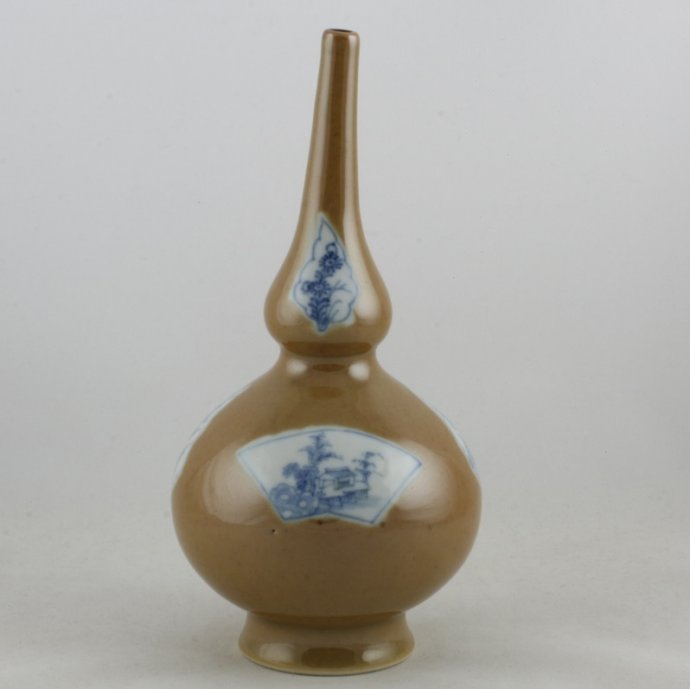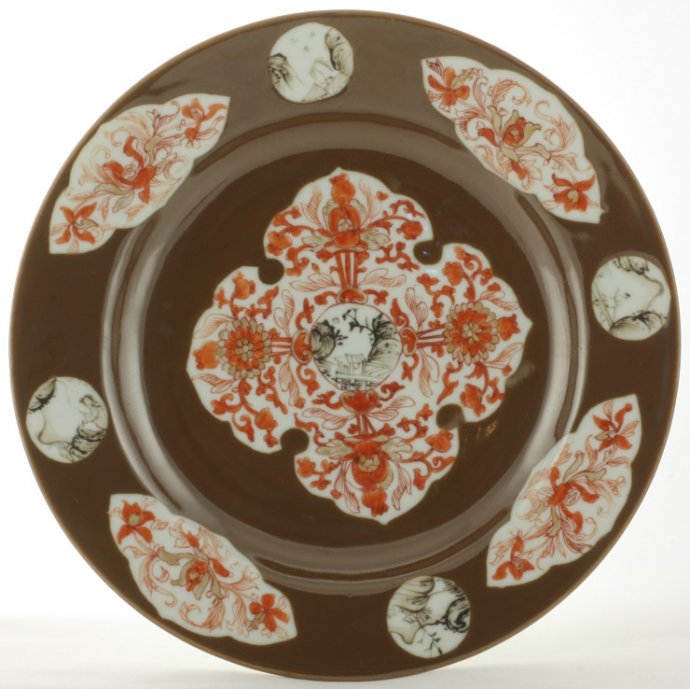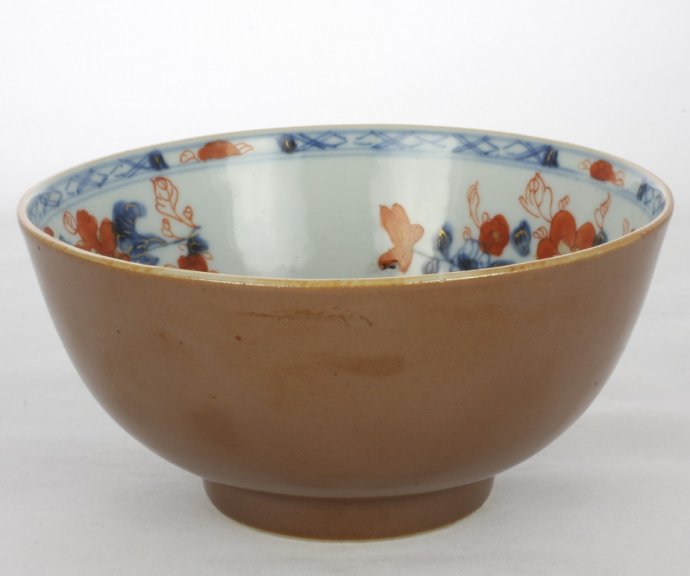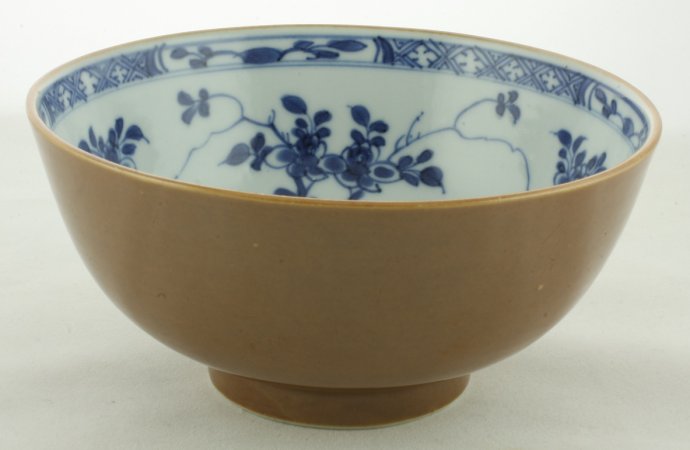Sold Ceramics
Sold Batavia Brown (Capucin wares) 1700-1800
Other wares
Page 1
In the Netherlands, porcelain decorated in this type of underglaze brown has historically been called "Batavia Brown" or "Capucijnergoed" ("Chick-pea ware", after the legume). The first name may have been coined because most goods exported to The Netherlands from the East were sent via Batavia and has nothing to do with a Batavian production or decoration, It is a very common type with the decoration usually contained within medallions. Occasionally, a gold decoration has been painted on the brown glaze. The brown colour is achieved by using iron oxide as a pigment, which like underglaze blue, needs to be fired at high temperatures. Considerable quantities were exported to the Western and Inter-Asian markets from c.1700. The pieces are rarely refined and can be considered as articles for everyday use by the middle-classes. (Jörg 2002/2, p.120)

Sold Ceramics - Sold Batavia Brown (Capucin wares) 1700-1800 - Other wares - Page 1
Object 2012178
Rosewater sprinkler
China
1700-1720
Height 195 mm (7.68 inch), diameter 95 mm (3.74 inch), diameter of mouthrim 6 mm (0.24 inch), diameter of footring 46 mm (1.81 inch), weight 386 grams (13.62 ounce (oz.))
Double-gourd rosewater sprinkler with spherical body gradually tapering into a long-pointed neck on a tall, spreading foot with a deep recessed glazed base. Covered with underglaze light brown with reserved decoration in underglaze blue of fan-shaped panels filled with a riverscape and leaf-shaped panels filled with a flowering plant.
The shape draws on Persian metalwork designs from the 16th and 17th centuries. Fragrant rosewater (gulaul) was used for refreshment, cleaning and scenting at both religious and secular events in the Islamic world. In Western settlements all over Asia they were widely-used as well. (Düsseldorf 2015, p.276)
Rose water sprinklers, known as gulabpash, have been used in India since the Mughal period for the purpose of refreshing oneself by moistening one's face, washing hands after a meal or for sprinkling a visitor as a gesture of welcome. Dutch traders discovered them in India and subsequently ordered porcelain bottles in various designs to be made in China. These bottles were partly sold in the Ottoman Empire, where local silversmiths fashioned artistic stoppers for them. Today, rose water bottles are found in the Sultan's Collection in Istanbul as well as in some Dutch museums, for example the Princessehof in Leeuwarden or the Museum Boijmans van Beuningen. (Suebsman 2019, p.74)
Perfumation and thurification have a very long history and can be traced back to prehistoric times. For thurification various types of incense burners were and are used until this day. For perfumation, rose-water was used that was stored and applied in specially made sprinklers. (META-Museum: Chinese Export Silver for the Islamic World, (A. von Ferscht, www.chinese-export-silver.com))
Rosewater sprinklers were are known to be decorated in underglaze blue, in 'Red & Gold' or 'Rouge de Fer' , or the body was (partly) covered in powder blue, Batavia brown or some other monochrome colour. At first they were only exported and used as such in Batavia later on in the West they were often fitted with metal or silver mounts. In the Netherlands they served as curiosities and decorative items. (Jörg & Van Campen 1997, p136)
For an identically shaped, sized and decorated rosewater sprinkler please see;
Condition: Perfect.
References:
Jörg & Van Campen 1997, cat. 140
Price: Sold.

Sold Ceramics - Sold Batavia Brown (Capucin wares) 1700-1800 - Other wares - Page 1
Object 2011296
Dish
China
1740-1760
Height 30 mm (1.18 inch), diameter of rim 226 mm (8.90 inch), diameter of footring 122 mm (4.80 inch)
Dish on a footring with a glazed base and a flattened rim. Batavia Brown covered with underglaze light brown. Decorated in 'Red & Gold' / 'Rouge-de-fer' with encre de Chine and gold on the glaze. In the centre a reserved four pointed scalloped cartouche, a central roundel is decorated with a riverscape with a pavilion, rocky banks and trees, the roundel is surrounded by flowering peony plants alternating with flowering chrysanthemum plants. The scalloped reserves on the rim are filled with flowering peony plants alternating with reserved roundels, filled with riverscapes. The reverse is undecorated.
The combination of an object covered in Batavia Brown with 'Red & Gold' / 'Rouge-de-fer' and encre de Chine and gold on the glaze is unusual and rare.
For an identically shaped and decorated dish, please see:
Condition: A firing flaw to the exterior wall and a fleabite to the rim..
References:
Jörg & Van Campen 1997, cat. 143 & cat. 251
Price: Sold.
More pictures of object 2011297, another identically shaped, sized and decorated, sold dish >>
More pictures of object 2011298, another identically shaped, sized and decorated, sold dish >>

Sold Ceramics - Sold Batavia Brown (Capucin wares) 1700-1800 - Other wares - Page 1
Objects 2011750 & 2011751
A pair of miniature 'doll's house' vases
China
1750-1770
2011750 height 72 mm (2.83 inch), diameter 43 mm (1.69 inch), diameter of mouthrim 10 mm (0.39 inch), diameter of footring 24 mm (0.94 inch), weight 50 grams (1.76 ounce (oz.))
2011751 height: 72 mm (2.83 inch), diameter 42 mm (1.65 inch), diameter of mouthrim 10 mm (0.39 inch),
diameter of footring 24 mm (0.94 inch), weight 51 grams (1.80 ounce (oz.))
A pair of pear-shaped miniature 'doll's house' vases on a flat unglazed base. Covered with an even underglaze dark brown. Decorated in overglaze green, pink and black enamel with flowerheads and scrolls in two leaf-shaped panels.
At the beginning of the 18th century, there was a fashion among wealthy Dutch ladies to have models made on the scale of a house, the so called "doll's houses". The rooms of these doll's houses were furnished with miniature pieces of porcelain, furniture, paintings, upholstery and all other sorts of objects that would have belonged to the interior of a wealthy home. These doll's houses were very costly and certainly not meant for children to play with but were proudly displayed for friends and visitors and regarded as extremely luxurious items - counterparts of the cabinets of curiosities that were a fashionable hobby of rich men. Only a few of these doll's houses have been preserved. One example can be found in the Gemeentemuseum in The Hague showing an 18th century room with porcelain miniatures in cupboards and on brackets along the wall. In reality the majority of these "miniature doll's house vases" would have been part of the interior. A good example of an authentic porcelain room is the famous cabinet in Pommersfelden Castle, Germany, where groups of pieces on brackets are surrounded by these miniature vases lining the borders of the consoles. (Jörg & Flecker 2001, pp.50-51)
Condition:
2011750: Perfect.
2011751: Perfect.
Reference:
Price: Sold.

Sold Ceramics - Sold Batavia Brown (Capucin wares) 1700-1800 - Other wares - Page 1
Object 2010113
Bowl
China
1740-1760
Height 70 mm (2.76 inch), diameter of rim 147 mm (5.79 inch), diameter of footring 63 mm (2.48 inch)
Bowl on footring. The outside Batavia Brown covered with underglaze dark brown. The inside Chinese Imari, decorated in underglaze blue, iron-red and gold. On the bottom a single flowering peony encircled by a single, concentric band. On the sides three flowering peony sprays in various stages of bloom. Around the rim a trellis pattern border with four reserves filled with a single flowering peony.
Batavia brown was very popular in the Netherlands and the Dutch East Indies. On this bowl the Batavia brown decoration method is combined with the popular Chinese Imari decorating style. (Jörg & Van Campen 1997, p.137)
Condition: Perfect.
References:
Jörg & Van Campen 1997, cat. 143
Price: Sold.

Sold Ceramics - Sold Batavia Brown (Capucin wares) 1700-1800 - Other wares - Page 1
Object 2010899
Vase
China
1740-1760
Height 197 mm (7.76 inch), diameter 101 mm (3.98 inch), diameter of mouthrim 29 mm (1.14 inch), diameter of footring 58 mm (2.28 inch)
Vase on a footring. Fitted with an unmarked Indonesian silver engraved mount. Batavia Brown covered with underglaze dark brown. Polychrome decorated in various, famille rose, overglaze enamels. On the body leaf-shaped reserves filled with flowering chrysanthemum and peony plants alternating with two smaller reserves filled with a single flowering plant.
This vase probably had an Indonesian provenance and was collected by a (former) owner when he or she lived in the Dutch East Indies. The mount, enhancing the shape, indicate the value such pieces had in local Indonesian communities, where they were often regarded as pusaka, holy and venerated heirlooms. (Jörg 2003/1, p.65)
Condition: Perfect.
References:
Jacquemart & Le Blant 1862, pp.77-105
Price: Sold.

Sold Ceramics - Sold Batavia Brown (Capucin wares) 1700-1800 - Other wares - Page 1
Object 201026
Bowl
China
1740-1760
Height 70 mm (2.76 inch), diameter of rim 147 mm (5.79 inch), diameter of footring 61 mm (2.40 inch)
Bowl on a footring with a glazed base and a straight rim. The outside is covered with so-called Batavia-Brown, underglaze dark brown. Decorated in underglaze blue on the bottom with a single flowering peony encircled by a single, concentric band and on the sides two flowering plants. Around the rim a trellis pattern border with four reserves filled with a flower spray.
On this bowl the Batavia Brown decoration method is combined only with an underglaze blue decorating style.
Condition: Perfect.
Reference:
Price: Sold.


 create websites
create websites